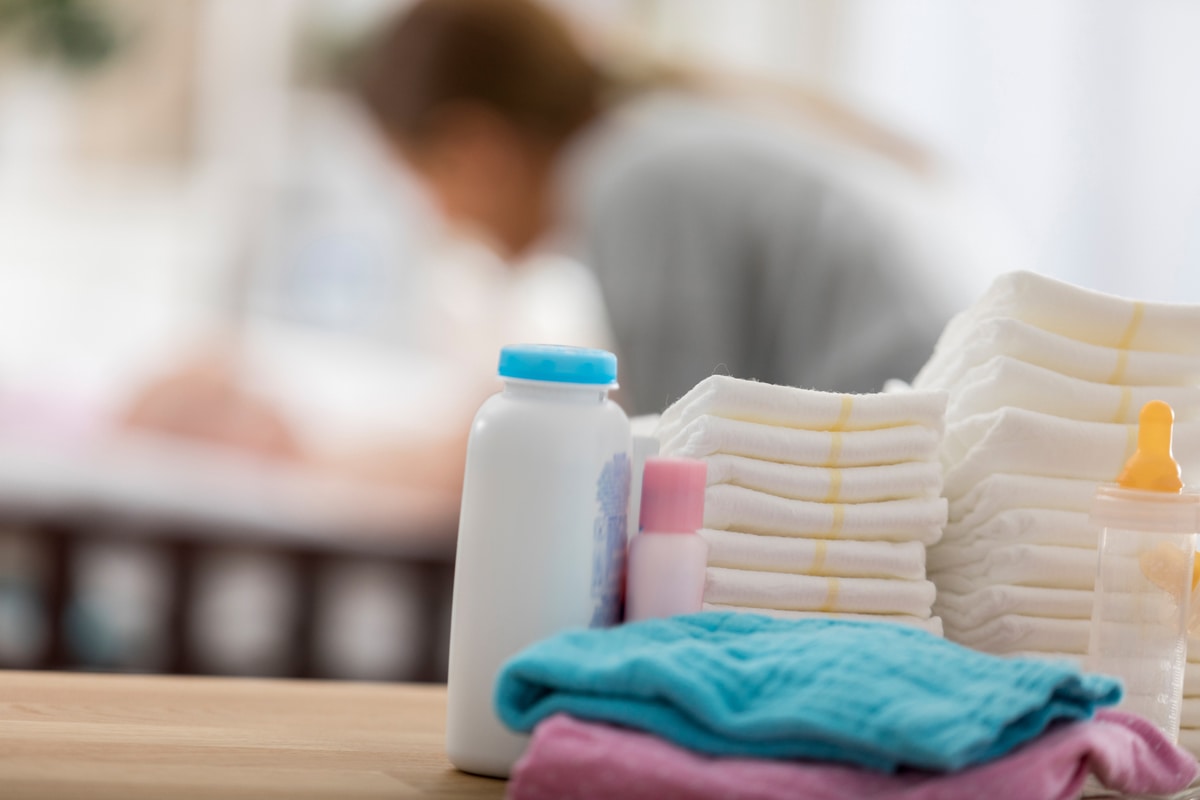Generally speaking, ovarian cancer is not a hot-button topic. However, in 2019, it will be – and you may be surprised why.
Talc is a natural mineral found in metamorphic rocks. One of the softest materials, talc can be ground into a powder – talcum powder – and used to absorb moisture and reduce friction. For these reasons, it will help prevent diaper rash, as well as chafing and other skin irritations.
Sounds like a great product! How could talcum powder cause cancer?
This year, Johnson & Johnson, the world’s largest maker of health-care products, will face multiple lawsuits regarding its Johnson’s Baby Powder. Women contend the company’s talcum powder contains asbestos, a known carcinogen. To date, it has been an up-and-down road through litigation for the company.
In 2017, a jury in Los Angeles awarded $417 million in damages to Eva Echeverrian. She developed ovarian cancer after using Johnson’s Baby Powder on her perineum for decades. (1)
In 2018, a jury in New Brunswick, New Jersey, ruled in favor of Johnson & Johnson in a case involving Rosalind Henry. She alleged that the company’s baby powder contained asbestos and caused her mesothelioma. (2)
Also last year, a Reuters investigation tackled the talcum powder-cancer link: (3)
A Reuters examination … shows that from at least 1971 to the early 2000s, the company’s raw talc and finished powders sometimes tested positive for small amounts of asbestos, and that company executives, mine managers, scientists, doctors, and lawyers fretted over the problem and how to address it while failing to disclose it to regulators or the public.
The documents also depict successful efforts to influence U.S. regulators’ plans to limit asbestos in cosmetic talc products and scientific research on the health effects of talc.
So, what does the science say?
Just the facts, ma’am
Ovarian cancer accounts for more deaths than any other cancer of the female reproductive system. Overall, it is the fifth-leading cause of cancer deaths among women. According to the American Cancer Society, a woman’s risk of getting ovarian cancer is about 1 in 78. The chance of dying from ovarian cancer is about 1 in 108. (4)
Here are some things to know about ovarian cancer: (5)
- There is no recommended test to screen for ovarian cancer, so it is rarely diagnosed early.
- In 2017, there were more than 20,000 new cases of ovarian cancer and more than 14,000 deaths.
- When ovarian cancer is found early, a woman has nearly a 93% chance of surviving at least 5 years after she is diagnosed.
- Those chances drop off significantly – to about 30% – if the cancer is found after it has spread to other parts of her body.
Based on research studies, women who have used talcum powder are about 30% more likely to be diagnosed with ovarian cancer than women who have not. (6)
Notably, in 2009, the United States Food and Drug Administration conducted a small survey of talc-containing cosmetics, including baby powder. The FDA concluded that none of the products they tested contained asbestos. The report found, “these results [are] informative, they do not prove that most or all talc or talc-containing cosmetic products currently marketed in the United States are likely to be free of asbestos contamination.” (7)
The National Center for Health Research, however, noted “the FDA does not require companies to provide information on safety to them. Therefore, consumers must rely on the companies to follow through on their duty to warn.” (Because they are not prescription drugs and are not claiming to treat or cure a condition, these products do not need to comply with the same FDA safety regulations as pharmaceuticals.)
Nonetheless, the National Center for Health Research warned, “As the debate continues, the bottom line is, if you can, avoid using these products for your health and your family’s health.” (8)
That bears repeating: The bottom line is, if you can, avoid using these products for your health and your family’s health.
It’s also worth remembering what the Reuters investigation uncovered. Johnson & Johnson lawyers fretted over the problem (raw talc and finished powders sometimes tested positive for small amounts of asbestos) and failed to disclose it to regulators or the public.
So, is talcum powder linked to cancer?
The International Agency for Research on Cancer (IARC), a part of the World Health Organization (WHO), classifies talc that contains asbestos as “carcinogenic to humans.” (Carcinogenic means “having the potential to cause cancer.”) That’s not good.
Also, based on limited evidence from human studies of a link to ovarian cancer, the IARC classifies the genital use of talc-based body powder as “possibly carcinogenic to humans.”
On the other hand, the IARC classifies inhaled talc not containing asbestos as “not classifiable as to carcinogenicity in humans.” (This is based on the lack of data from human studies and on limited data in lab animal studies.)
Confused yet? According to the IARC, talcum powder is, could be, or is not a cause for concern when it comes to cancer. … OK, got it.
Dr. Mary Jane Minkin, a clinical professor of obstetrics, gynecology, and reproductive services at Yale School of Medicine, said, “The data is wishy-washy. Some studies haven’t found a connection, and other ones have only shown a small increase in the hazard ratio [or risk]. And there are lots of different variables in these studies for researchers to consider.” (9)
One thing is sure: Johnson & Johnson is facing a mountain of litigation in the coming months. With more than 11,000 talc cases on various dockets, analysts at Bloomberg estimated that Johnson & Johnson may have to pay as much as $20 billion to get rid of what has become a significant mass tort for the company. (10)
Citations
(1) Roni Caryn Rabin. The New York Times. $417 Million Awarded in Suit Tying Johnson’s Baby Powder to Cancer. https://www.nytimes.com/2017/08/22/health/417-million-awarded-in-suit-tying-johnsons-baby-powder-to-cancer.html
(2) Tina Bellon. Reuters. Jury clears J&J of liability in New Jersey talc cancer case. https://www.reuters.com/article/us-johnson-johnson-cancer-lawsuit/jury-clears-jj-of-liability-in-new-jersey-talc-cancer-case-idUSKCN1ML2QF
(3) Lisa Girion. Reuters. Johnson & Johnson knew for decades that asbestos lurked in its Baby Powder. https://www.reuters.com/investigates/special-report/johnsonandjohnson-cancer/
(4) American Cancer Society. Key Statistics for Ovarian Cancer. https://www.cancer.org/cancer/ovarian-cancer/about/key-statistics.html
(5) U.S. Preventive Services Task Force. Final Recommendation Statement: Ovarian Cancer: Screening. https://www.uspreventiveservicestaskforce.org/Page/Document/RecommendationStatementFinal/ovarian-cancer-screening1
(6) Wera Berge, Kenneth Mundt, Hung Luu, and Paolo Boffetta. Genital use of talc and risk of ovarian cancer: a meta-analysis. http://cdn.cnn.com/cnn/2017/images/11/15/genital_use_of_talc_and_risk_of_ovarian_cancer___a.99354.2017.july.meta.pdf
(7) FDA.gov. Cosmetics Products and Ingredients: Talc. https://www.fda.gov/Cosmetics/ProductsIngredients/Ingredients/ucm293184.htm
(8) Diana Zuckerman, Danielle Shapiro. National Center for Health Research. http://www.center4research.org/talcum-powder-ovarian-cancer/
(9) Maria Masters and Amanda MacMillan. Can Using Baby Powder Down There Really Cause Cancer? A New Investigation Offers More Clues. https://www.health.com/mind-body/can-using-baby-powder-down-there-really-cause-cancer
(10) Jef Feeley, Margaret Cronin Fisk. J&J’s Risk From Tainted-Talc Lawsuits Only Gets Bigger in 2019. https://www.bloomberg.com/news/articles/2018-12-21/j-j-s-tainted-talc-risk-expands-as-cancer-trials-triple-in-2019

